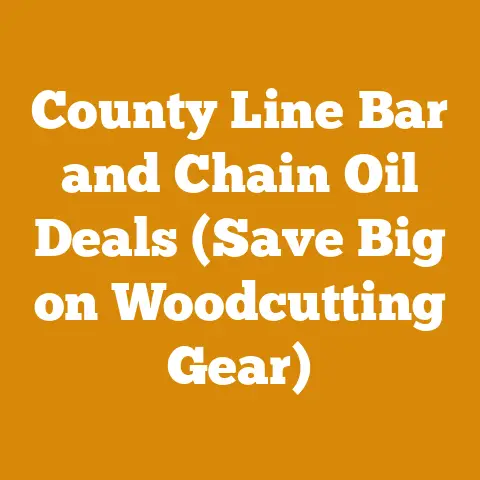Are There Different Types of Magnolia Trees? (5 Wood Processing Insights)
I remember the first time I was tasked with clearing a stand of mixed hardwoods, including a few majestic magnolias, on my uncle’s property.
I thought, “Wood is wood, right?” Wrong.
And let me tell you, the costs can spiral out of control faster than a runaway log truck if you’re not careful.
So, you’re asking, “Are there different types of Magnolia trees?” Absolutely.
And that seemingly simple question opens a whole can of worms (or, perhaps more appropriately, a whole log pile) when you consider its implications for wood processing, logging, and firewood preparation.
But understanding the species you’re working with is only half the battle.
The other half is mastering the art of budgeting and cost management.
Let’s dive into the world of magnolia, explore its different varieties, and then get down to brass tacks about the real cost of turning trees into usable wood.
We’ll cover everything from chainsaw selection to firewood pricing, with some personal anecdotes and industry insights sprinkled in for good measure.
The Magnolia Family: A Woodworker’s Primer
Magnolia trees, with their iconic blooms and stately presence, are more diverse than you might think.
Knowing the characteristics of different magnolia species is crucial for successful wood processing.
1. Southern Magnolia (Magnolia grandiflora): The King of the South
- Characteristics: This is the quintessential magnolia, known for its large, fragrant white flowers and glossy evergreen leaves.
The wood is moderately hard and close-grained. - Wood Properties: Southern magnolia wood is relatively easy to work with, making it suitable for furniture, veneer, and interior trim.
It’s not particularly durable outdoors. - My Experience: I once used Southern magnolia to build a small side table.
The wood took stain beautifully, but I made sure to seal it well since it’s not naturally rot-resistant.
2. Sweetbay Magnolia (Magnolia virginiana): The Adaptable Cousin
- Characteristics: A smaller, semi-evergreen magnolia with smaller, creamy white flowers.
It’s more adaptable to wet conditions than the Southern magnolia. - Wood Properties: The wood is softer and less dense than Southern magnolia, but still usable for light construction and crafts.
- Insight: Sweetbay magnolia is often overlooked, but its lighter weight makes it easier to handle for smaller projects.
3. Cucumbertree (Magnolia acuminata): The Northern Giant
- Characteristics: This magnolia is native to colder climates and can grow quite large.
It gets its name from the cucumber-like shape of its immature fruit. - Wood Properties: The wood is similar to yellow poplar (Liriodendron tulipifera) and is used for similar purposes, such as furniture framing and plywood.
- Note: Cucumbertree is often harvested and sold as “yellow poplar” due to the similarity in wood properties.
4. Saucer Magnolia (Magnolia × soulangeana): The Ornamental Hybrid
- Characteristics: A popular ornamental magnolia with large, showy pink or purple flowers that bloom in early spring.
- Wood Properties: The wood is generally not used commercially due to the tree’s smaller size and ornamental value.
However, if you do have to take one down, the wood can be used for small craft projects. - Caution: Be careful when processing Saucer magnolia; the branches can be brittle and unpredictable.
5. Star Magnolia (Magnolia stellata): The Compact Beauty
- Characteristics: A small, shrubby magnolia with star-shaped white flowers.
- Wood Properties: Similar to Saucer magnolia, the wood is primarily used for small craft projects or firewood due to the tree’s size.
Magnolia Wood: A Summary Table
Note: Hardness and Density are relative within the Magnolia family.
Durability refers to untreated wood.
5 Key Wood Processing Insights & Cost Factors
Now that we’ve covered the magnolia family tree (pun intended!), let’s get into the nitty-gritty of wood processing and the costs involved.
Here are five key insights I’ve gained over the years:
1. Chainsaw Selection: Power vs. Precision vs. Price
The chainsaw is the workhorse of any wood processing operation.
Choosing the right one can significantly impact your efficiency and costs.
- Gas vs.
Electric: Gas chainsaws offer more power and portability, while electric chainsaws are quieter, lighter, and require less maintenance.
Battery powered chainsaws are getting better all the time, and are great for jobs that aren’t too big. - Bar Length: The bar length should be appropriate for the size of the trees you’re cutting.
A longer bar allows you to fell larger trees, but it also adds weight and can be more difficult to control. - Engine Size: A larger engine provides more power, but it also consumes more fuel.
- Cost Factors:
- Initial Purchase Price: Gas chainsaws typically range from \$150 to \$1000+, while electric chainsaws range from \$100 to \$500+.
- Fuel Costs: Gas chainsaws require gasoline and oil, which can add up over time.
The average cost of gasoline is around \$3.50 per gallon (as of late 2024), and oil typically costs around \$10 per quart. - Maintenance Costs: Gas chainsaws require more frequent maintenance, such as spark plug replacements, air filter cleaning, and carburetor adjustments.
Electric chainsaws require less maintenance, but the batteries will eventually need to be replaced. - Chain Sharpening: A dull chain can significantly reduce your cutting efficiency and increase the risk of kickback.
You can sharpen your own chain with a file or grinder, or you can take it to a professional.
Professional sharpening typically costs around \$10-\$20 per chain.
- My Recommendation: For most homeowners, a mid-range gas chainsaw with a 16-18 inch bar is a good choice.
For smaller jobs, an electric chainsaw can be a convenient and cost-effective option. - Data Point: According to a survey by Popular Mechanics, the average lifespan of a gas chainsaw is 5-10 years, while the average lifespan of an electric chainsaw is 3-7 years.
2. Log Splitting: Manual vs. Mechanical – A Back-Saving Analysis
Splitting logs can be a back-breaking task, but there are several options to make the job easier.
- Manual Splitting: Using a maul or splitting axe is the most affordable option, but it requires significant physical effort.
- Hydraulic Log Splitters: These machines use hydraulic pressure to split logs.
They are available in both gas and electric models. - Screw-Type Log Splitters: These splitters use a rotating screw to force the log apart.
They are typically less expensive than hydraulic splitters, but they can be slower. - Cost Factors:
- Manual Splitting Tools: A good quality maul or splitting axe can cost anywhere from \$50 to \$200.
- Hydraulic Log Splitters: Gas-powered hydraulic log splitters typically range from \$800 to \$3000+, while electric models range from \$500 to \$2000+.
- Screw-Type Log Splitters: These typically cost between \$300 and \$800.
- Rental Costs: If you only need to split logs occasionally, renting a log splitter may be a more cost-effective option.
Rental rates typically range from \$50 to \$100 per day.
- My Experience: After a particularly grueling weekend of splitting firewood with a maul, I invested in a hydraulic log splitter.
It was worth every penny! - Data Point: According to the U.S.
Consumer Product Safety Commission, there are approximately 28,000 injuries related to log splitters each year.
Always wear appropriate safety gear, including gloves, eye protection, and sturdy footwear.
3. Seasoning Firewood: Time is Money (and Dry Wood Burns Best)
Seasoning firewood is the process of drying the wood to reduce its moisture content.
Dry wood burns hotter and cleaner than green wood.
- Drying Time: The drying time depends on the type of wood, the climate, and the stacking method.
Hardwoods typically take 6-12 months to season, while softwoods can season in as little as 3-6 months. - Stacking Method: Stacking the wood in a single row, off the ground, and with good air circulation will speed up the drying process.
- Moisture Content: The ideal moisture content for firewood is below 20%.
You can use a moisture meter to check the moisture content of your wood. - Cost Factors:
- Storage Space: You’ll need a dry, well-ventilated space to store your firewood.
- Moisture Meter: A moisture meter can cost anywhere from \$20 to \$100+.
- Time: Seasoning firewood takes time, which can be a significant cost if you’re relying on it for heat.
- My Tip: I always sticker my firewood stacks (placing small pieces of wood between the rows) to improve air circulation.
- Formula: Estimated Drying Time (months) = (Initial Moisture Content – Target Moisture Content) / Drying Rate.
The drying rate varies depending on climate and wood species.
4. Transportation and Storage: Getting the Wood Where it Needs to Be
Moving logs and firewood can be a significant expense, especially if you don’t have the right equipment.
- Equipment: You may need a truck, trailer, tractor, or skid steer to transport logs and firewood.
- Distance: The further you have to transport the wood, the higher the transportation costs will be.
- Storage: You’ll need a place to store the wood, which may require building a shed or renting storage space.
- Cost Factors:
- Vehicle Costs: The cost of fuel, maintenance, and insurance for your vehicle.
- Trailer Rental: Trailer rental rates typically range from \$30 to \$100 per day.
- Equipment Rental: Renting a tractor or skid steer can cost anywhere from \$100 to \$500 per day.
- Storage Costs: The cost of building a shed or renting storage space.
- My Story: I once tried to haul a load of firewood in my car.
Let’s just say it wasn’t a pretty sight (or smell).
Invest in a good trailer! - Data Point: According to the U.S.
Department of Energy, transportation accounts for approximately 10-15% of the total cost of firewood.
5. Permits and Regulations: Avoiding Costly Fines
Depending on where you live, you may need permits to harvest timber or sell firewood.
- Harvesting Permits: Many states and counties require permits to harvest timber, especially on public lands.
- Firewood Regulations: Some areas have regulations about the type of firewood you can transport, in order to prevent the spread of invasive insects and diseases.
- Business Licenses: If you’re selling firewood, you may need a business license.
- Cost Factors:
- Permit Fees: Permit fees vary depending on the location and the type of permit.
- Fines: Violating timber harvesting or firewood regulations can result in hefty fines.
- Legal Fees: If you get into a dispute with a landowner or regulatory agency, you may need to hire an attorney.
- My Advice: Always check with your local authorities before harvesting timber or selling firewood to ensure that you’re in compliance with all applicable regulations.
- Example: In some states, it’s illegal to transport firewood across state lines due to concerns about the emerald ash borer.
Budgeting for Wood Processing: A Step-by-Step Guide
Creating a budget is essential for managing the costs of wood processing.
Here’s a step-by-step guide:
- Define Your Project: What are you trying to accomplish?
Are you harvesting timber for sale, processing firewood for personal use, or building furniture? - Estimate Your Volume: How much wood do you need to process?
This will help you determine the amount of time, labor, and materials required. - Identify Your Costs: List all of the costs associated with your project, including:
- Timber Purchase or Harvesting Costs
- Tool Purchase or Rental Costs
- Fuel Costs
- Maintenance Costs
- Labor Costs
- Transportation Costs
- Storage Costs
- Permit Fees
- Research Prices: Get quotes from suppliers, contractors, and rental companies.
- Create a Spreadsheet: Use a spreadsheet to track your costs and compare them to your budget.
- Add a Contingency: Include a contingency fund to cover unexpected expenses.
I typically add 10-15% for unforeseen issues. - Monitor Your Spending: Track your spending throughout the project and make adjustments as needed.
Cost Comparison Table: Chainsaw Options
Calculating Firewood Volume: From Tree to Cord
Understanding how to calculate firewood volume is crucial for pricing and budgeting.
Here’s a simplified explanation:
- Cord: A cord of firewood is a stack of wood that measures 4 feet high, 4 feet wide, and 8 feet long, for a total volume of 128 cubic feet.
- Face Cord (or Rick): A face cord is a stack of wood that measures 4 feet high and 8 feet long, but the width varies.
The price of a face cord should be adjusted based on its width. - Estimating Volume from a Tree: Estimating the volume of firewood you can get from a tree is more complex, but you can use online calculators or consult with a professional forester.
Factors to consider include the tree’s diameter, height, species, and defect. - Board Feet: A measurement typically used for lumber, not firewood.
However, if you are milling logs into lumber, you’ll need to understand board feet.
One board foot is 1 inch thick, 12 inches wide, and 12 inches long.
Cost Optimization Tips for Wood Processing
Here are some practical tips for reducing your wood processing costs:
- Buy in Bulk: Purchasing timber or firewood in bulk can often save you money.
- Do it Yourself: Performing tasks like chainsaw sharpening and firewood splitting yourself can save on labor costs.
- Rent Equipment: Renting equipment instead of buying it can be a cost-effective option for occasional use.
- Season Firewood Properly: Properly seasoned firewood burns more efficiently, reducing the amount you need to burn.
- Negotiate Prices: Don’t be afraid to negotiate prices with suppliers and contractors.
- Use Salvaged Wood: Consider using salvaged wood from fallen trees or construction sites for your projects (with permission, of course!).
- Maintain Your Equipment: Regular maintenance can extend the life of your equipment and prevent costly repairs.
- Take Advantage of Tax Deductions: If you’re using wood for heating your home, you may be able to deduct some of the costs on your taxes.
Consult with a tax professional for more information. - Shop Around for Insurance: Compare insurance rates from different companies to find the best deal.
- Consider Group Purchasing: Partner with neighbors or friends to purchase equipment or materials in bulk.
- Attend Workshops and Training: Investing in training can improve your skills and efficiency, which can save you money in the long run.
Global and Regional Timber Prices: A Snapshot
Timber prices vary significantly depending on the region, species, and grade of lumber.
Here’s a snapshot of current market trends:
- North America: Softwood lumber prices have been volatile in recent years due to supply chain disruptions and increased demand.
As of late 2024, prices are still elevated compared to pre-pandemic levels. - Europe: European timber prices have also been affected by supply chain issues and increased demand for sustainable building materials.
- Asia: Asia is a major importer of timber, and prices are influenced by global demand and currency fluctuations.
- Firewood Prices: Firewood prices vary depending on the region, species, and quantity purchased.
The average price per cord of firewood in the United States is around \$250-\$400, but prices can be higher in urban areas or during periods of high demand.
Source: Forest Economic Advisors, Random Lengths, U.S. Energy Information Administration
Case Study: Budgeting for a Small-Scale Firewood Business
Let’s say you’re starting a small-scale firewood business. Here’s a sample budget:
- Equipment:
- Chainsaw: \$400
- Log Splitter: \$1000
- Truck and Trailer: \$5000 (used)
- Safety Gear: \$200
- Moisture Meter: \$50
- Total Equipment Costs: \$6650
- Operating Costs (per cord):
- Timber Purchase: \$50
- Fuel: \$20
- Maintenance: \$5
- Labor (splitting and stacking): \$30
- Transportation: \$10
- Storage: \$5
- Total Operating Costs (per cord): \$120
- Sales Price (per cord): \$350
- Profit (per cord): \$230
Note: These are just estimates, and your actual costs and profits may vary.
The Magnolia Connection: Tying it All Together
So, back to the original question: “Are there different types of Magnolia trees?” Yes, and each type has its own unique characteristics that affect its suitability for wood processing.
Understanding these characteristics, along with the costs associated with each step of the wood processing process, is crucial for success.
Whether you’re a hobbyist building furniture from Southern magnolia or a professional selling firewood from Cucumbertree, careful budgeting and cost management will help you make the most of this beautiful and versatile wood.
Actionable Takeaways and Next Steps
- Identify the Magnolia Species: Determine the specific type of magnolia you’re working with and research its properties.
- Assess Your Needs: What are you trying to accomplish with the wood?
This will help you determine the best processing methods and equipment. - Create a Budget: Develop a detailed budget that includes all of your costs.
- Shop Around: Get quotes from multiple suppliers and contractors.
- Start Small: If you’re new to wood processing, start with a small project and gradually increase the size and complexity.
- Stay Safe: Always wear appropriate safety gear and follow safe operating procedures.
- Continuously Learn: Attend workshops, read books, and talk to experienced woodworkers to improve your skills and knowledge.
The journey of wood processing is a constant learning experience.
Embrace the challenges, celebrate the successes, and never stop exploring the beauty and versatility of wood.
And remember, a little planning goes a long way towards keeping your costs under control and your projects on track.
Now, go forth and create something amazing!






